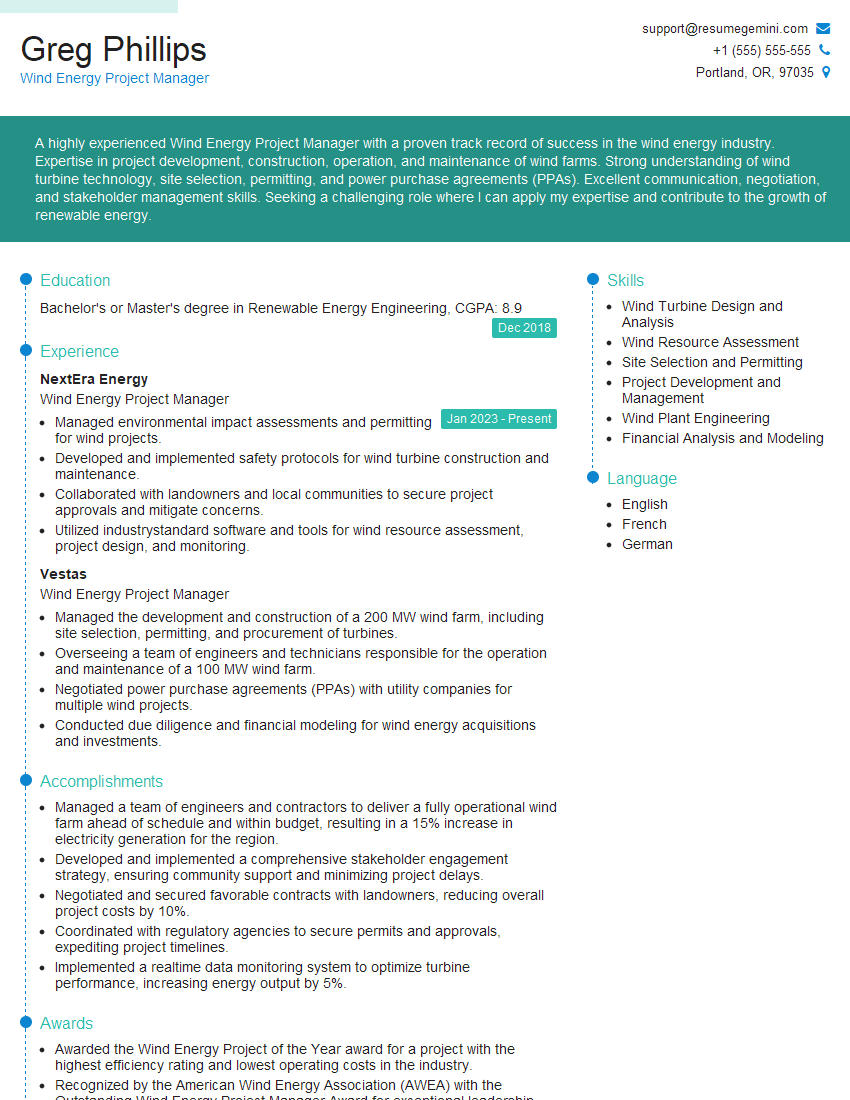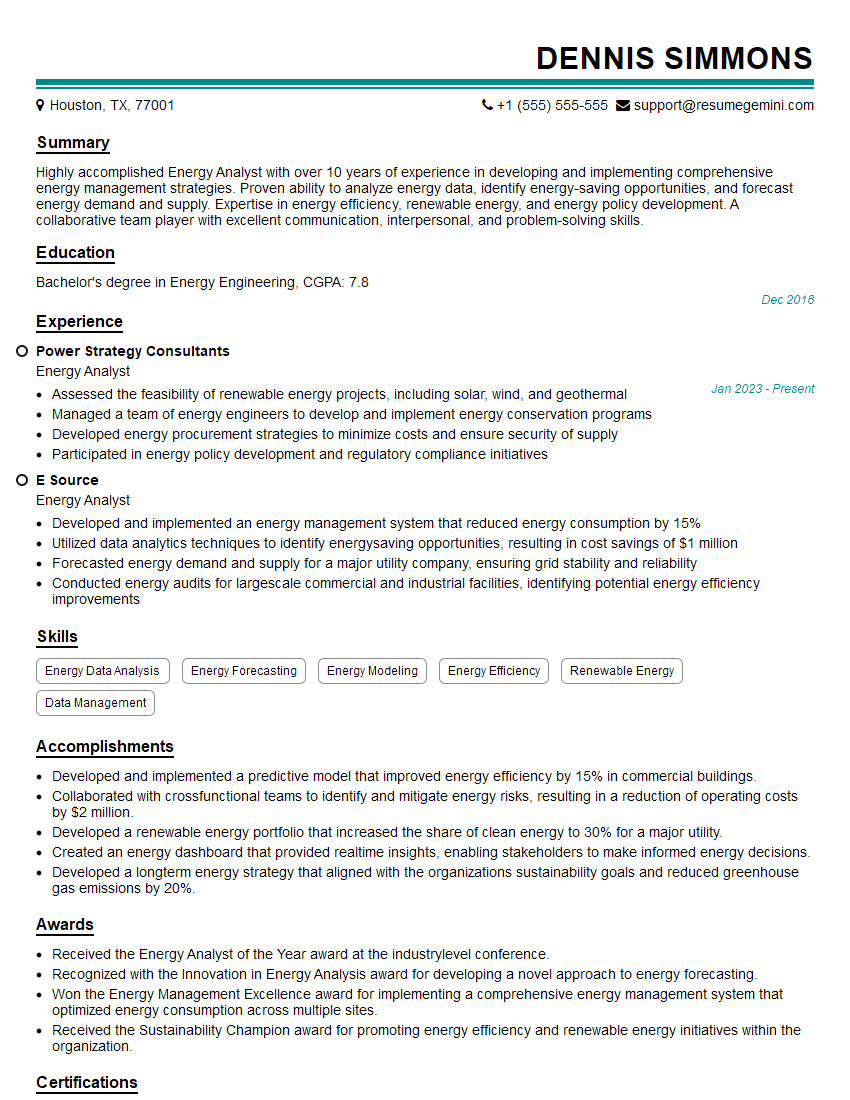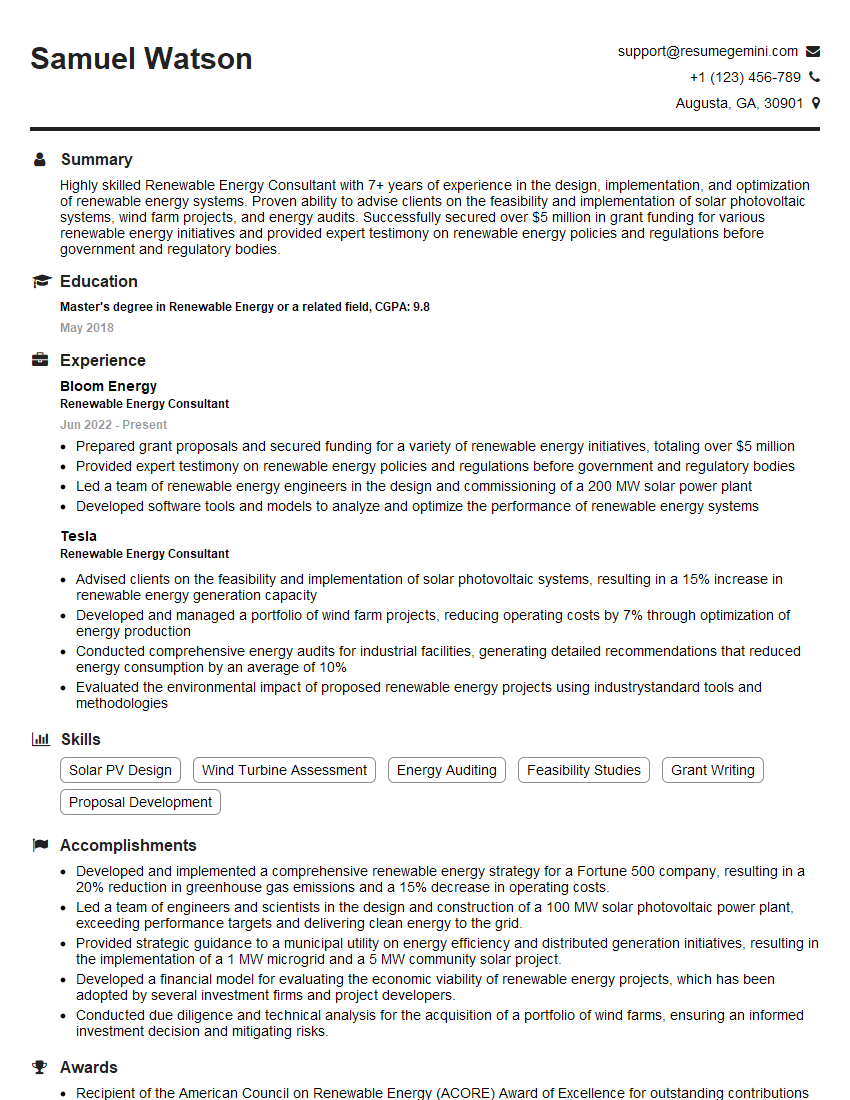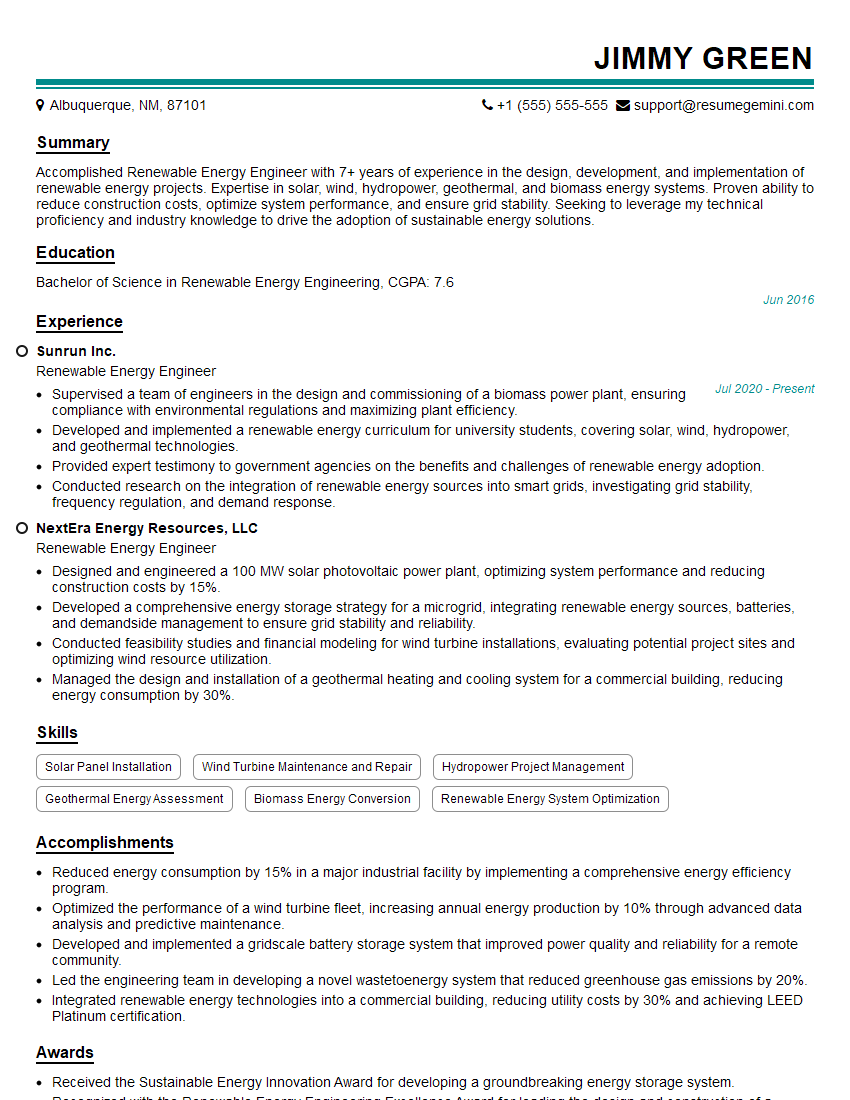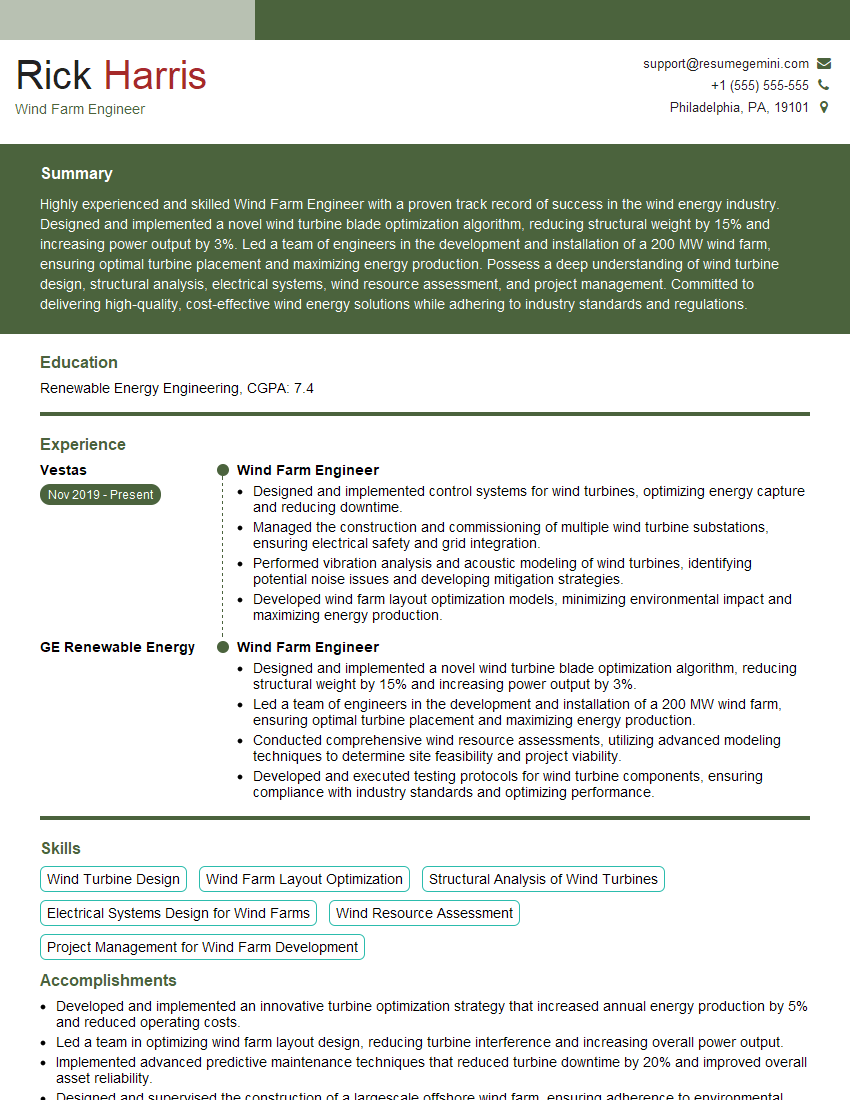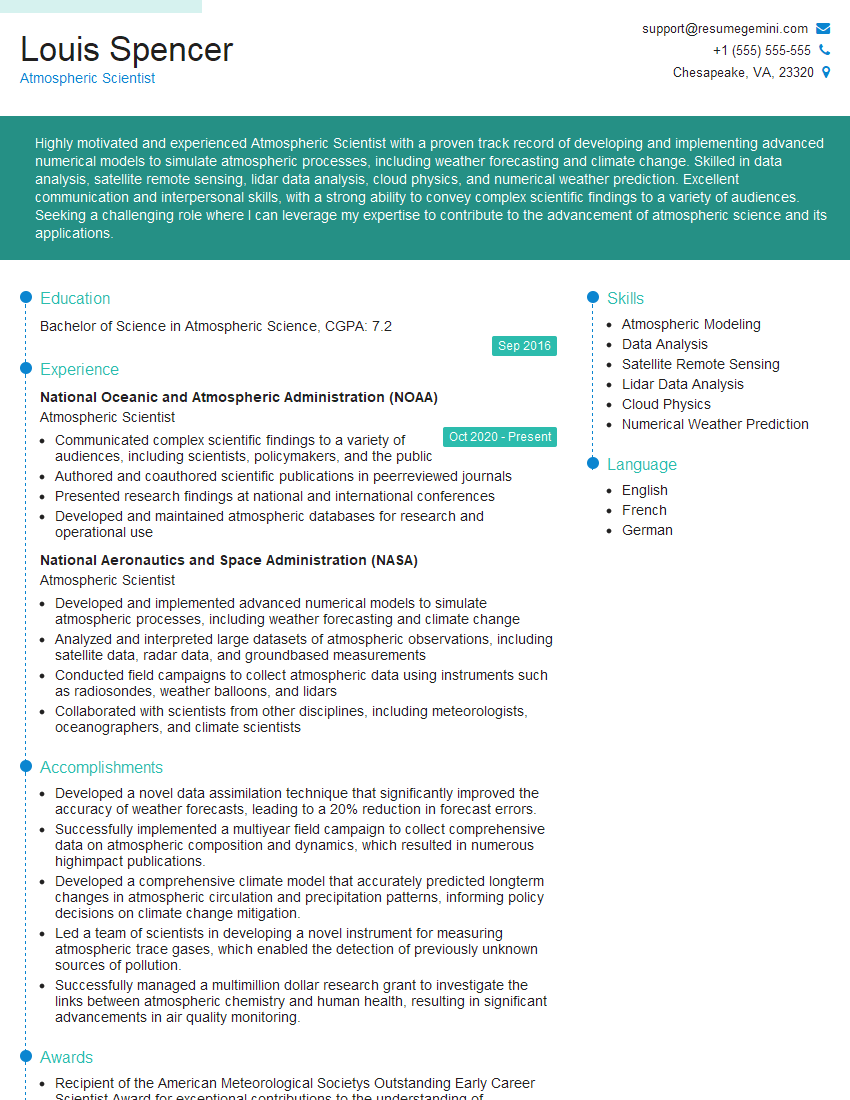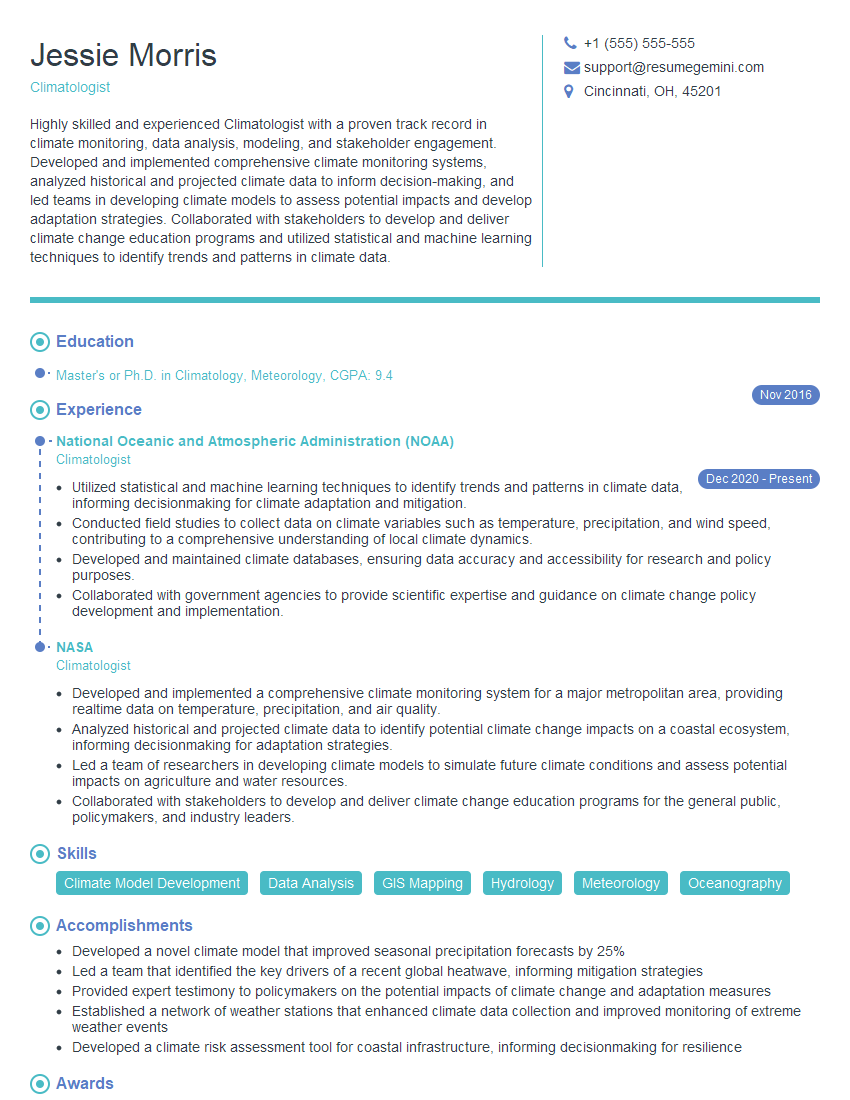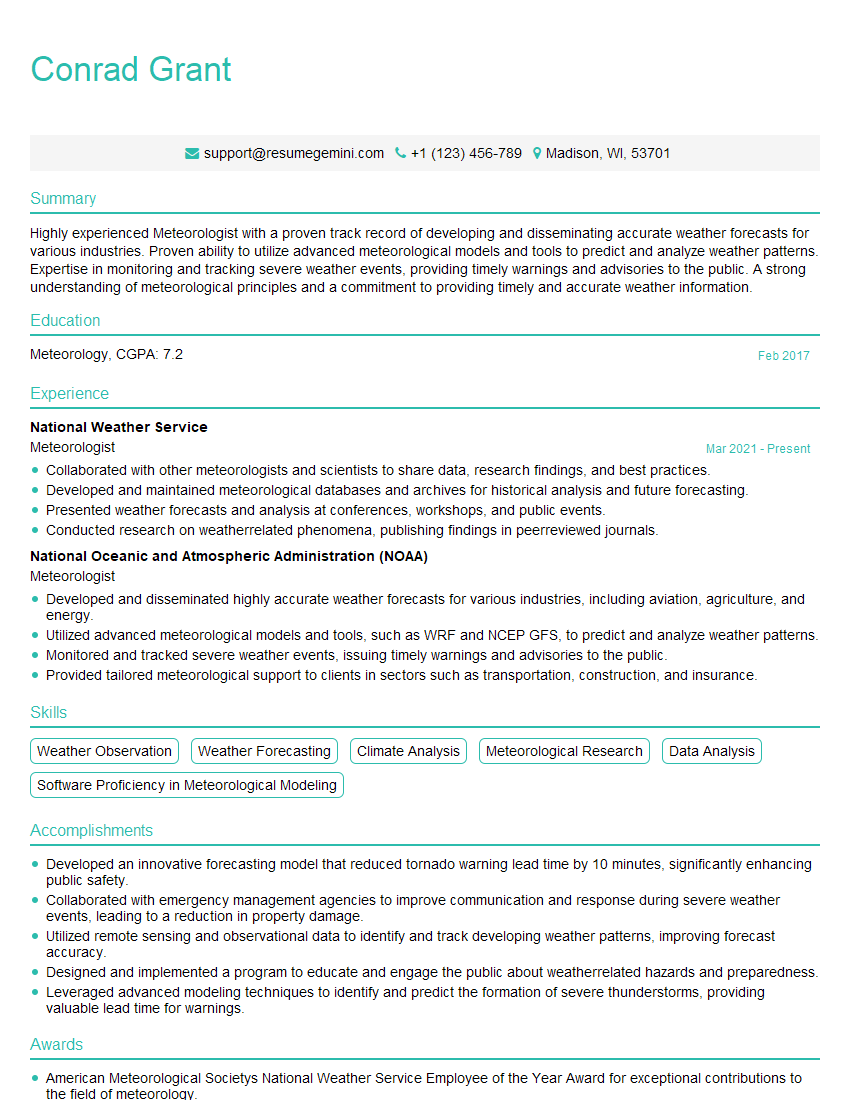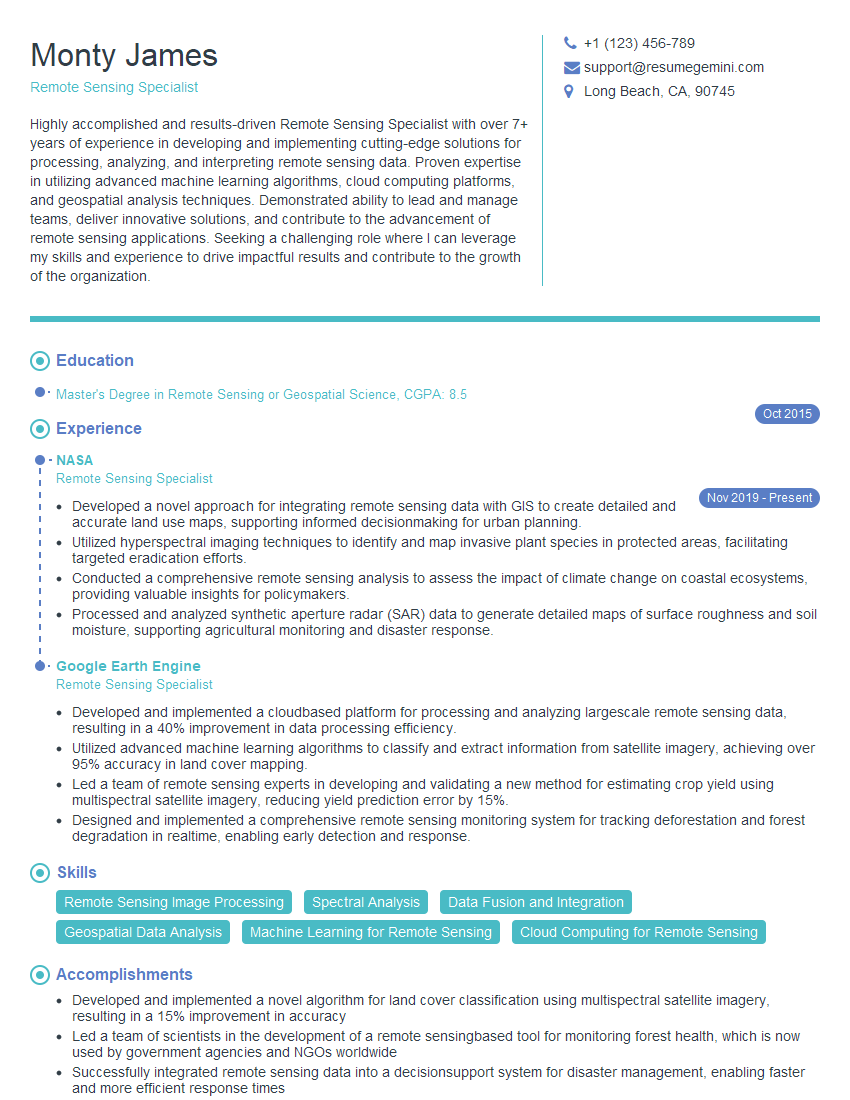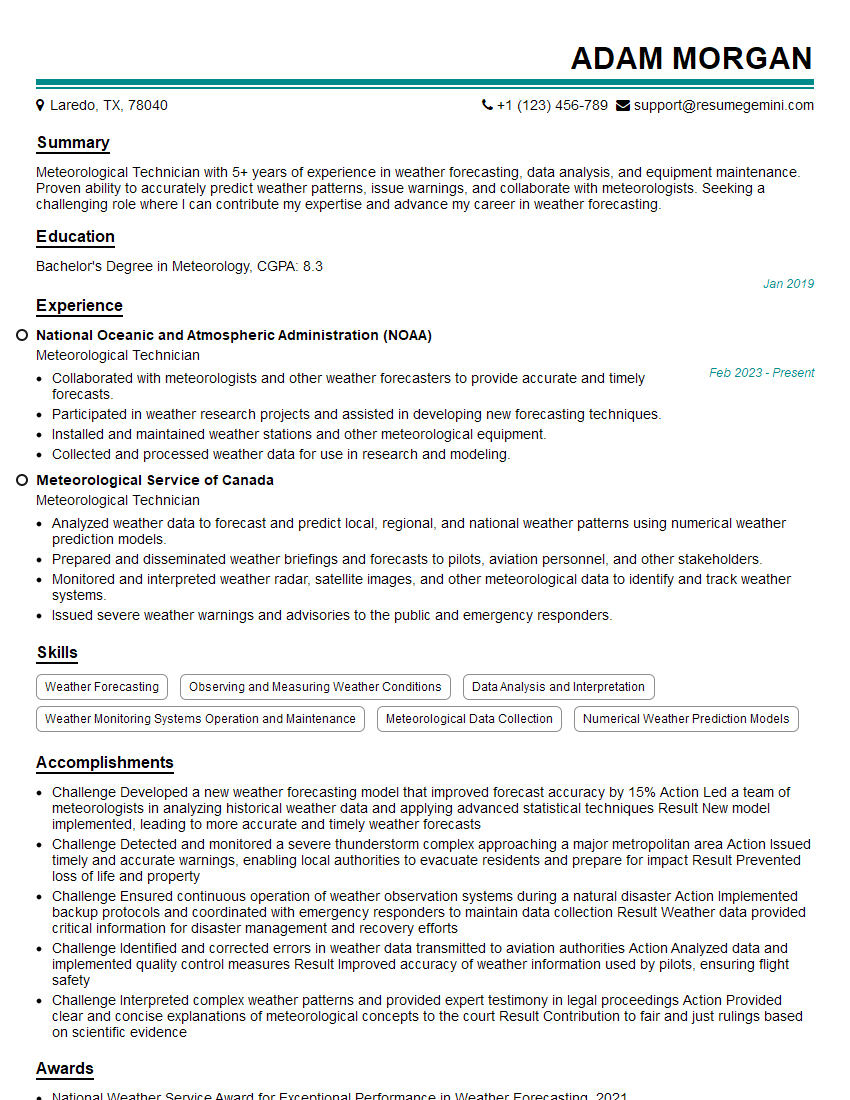Are you ready to stand out in your next interview? Understanding and preparing for Wind Direction Recognition interview questions is a game-changer. In this blog, we’ve compiled key questions and expert advice to help you showcase your skills with confidence and precision. Let’s get started on your journey to acing the interview.
Questions Asked in Wind Direction Recognition Interview
Q 1. Explain the different methods used to measure wind direction.
Wind direction is measured primarily using wind vanes and anemometers, although more advanced methods exist. Let’s explore each:
- Wind Vane: This is the simplest and most common method. A wind vane is a freely rotating indicator, typically shaped like an arrow, that aligns itself with the direction from which the wind is blowing. Think of it like a weathercock on a barn. The direction is indicated by the arrowhead pointing into the wind. The reading is then usually translated into degrees (0° representing North, 90° East, etc.).
- Anemometer with Wind Direction Sensor: Many modern anemometers incorporate a wind vane or similar sensor to measure both wind speed and direction simultaneously. These combined instruments provide comprehensive wind data.
- Sophisticated Remote Sensing: Advanced techniques like Doppler lidar and radar systems can remotely measure wind direction over large areas, offering detailed information for meteorological forecasts and research purposes. These use the Doppler effect to measure the shift in frequency of reflected signals, providing information on both speed and direction.
- Pilot Balloons: For historical context or in situations where other instruments are unavailable, tracking the movement of pilot balloons (small weather balloons) can give a general indication of upper atmospheric wind direction.
The choice of method depends on the application. For simple weather monitoring, a wind vane suffices. For detailed research or meteorological forecasting, advanced remote sensing techniques are preferable.
Q 2. Describe the principles behind anemometer operation.
Anemometers measure wind speed, not direction (though as noted above, many combine both). Their operation relies on the principle that the force of the wind exerts a measurable effect on a rotating component. There are several types, each with its own principle:
- Cup Anemometer: This is the most common type. Three or four hemispherical cups are mounted on a rotating arm. The wind pushes the cups around, and the rate of rotation is directly proportional to the wind speed. A sensor measures this rotation and converts it into a speed reading. Imagine a pinwheel spinning faster in a stronger breeze.
- Propeller Anemometer: A propeller spins as it interacts with the wind, similar to a miniature airplane propeller. Again, the speed of rotation directly corresponds to wind speed.
- Sonic Anemometer: This uses the speed of sound to indirectly measure wind speed. By measuring the time it takes for sound pulses to travel between sensors, the effect of wind on this transit time reveals wind speed and direction.
Regardless of the type, the core principle is that the faster the wind blows, the faster the anemometer’s rotating component spins or the more it is affected, translating this movement into a quantitative measurement of wind speed.
Q 3. How does wind direction affect wind turbine efficiency?
Wind direction significantly impacts wind turbine efficiency. Ideally, wind turbines operate most efficiently when the wind blows directly onto the blades (at 0° yaw angle). Any deviation from this optimal alignment reduces energy capture.
- Yaw Misalignment: When the wind direction deviates from the turbine’s orientation, the blades receive less direct wind force, reducing the energy harnessed. This yaw misalignment can significantly decrease efficiency, especially at large angles.
- Turbulence Effects: Wind direction changes and turbulence, particularly wind shear (discussed later), can also disrupt the smooth airflow over the turbine blades, impacting performance. Inconsistent or gusty winds with changing direction often mean reduced energy output.
- Control Systems: Modern wind turbines have sophisticated control systems that constantly adjust their orientation (yaw) to face the prevailing wind direction, helping to mitigate these efficiency losses. However, these systems cannot completely eliminate the impacts of changing wind directions or turbulence.
In essence, maintaining optimal alignment between the wind direction and the turbine is crucial for maximizing energy capture and efficiency. Consistent wind from a predictable direction is better than fluctuating wind direction.
Q 4. What are the common sources of error in wind direction measurement?
Several factors can introduce errors into wind direction measurements:
- Instrument Calibration: Inaccurate calibration of wind vanes or anemometers is a major source of error. Regular calibration against known standards is necessary to ensure accurate measurements.
- Obstructions: Buildings, trees, or terrain features can disrupt the airflow, leading to inaccurate readings. Ideally, wind sensors should be placed in open areas, free from obstacles that could deflect or alter the wind.
- Instrument Wear and Tear: Over time, mechanical components of wind vanes and anemometers can wear out, leading to friction and inaccurate measurements. Regular maintenance and replacement are important.
- Local Turbulence: Small-scale turbulence caused by local effects can cause temporary fluctuations in wind direction, resulting in noisy or inconsistent data.
- Sampling Frequency: The frequency at which data is sampled can influence the accuracy of the reported wind direction, particularly during rapidly changing conditions. Higher sampling rates are essential for resolving these short-term fluctuations.
Careful instrument selection, proper site selection, regular maintenance, and appropriate data processing techniques are crucial to minimizing errors in wind direction measurement.
Q 5. Explain the concept of wind shear and its impact on wind direction.
Wind shear refers to the change in wind speed or direction over a relatively short distance. This variation can be vertical (with altitude) or horizontal (across different locations).
- Impact on Wind Direction: Horizontal wind shear can cause significant variations in wind direction across a relatively small area. Imagine a situation where the wind at ground level is blowing from the west, but at a higher altitude, it’s blowing from the northwest. This difference complicates wind turbine design and operation, as the blades experience varying wind directions along their length.
- Turbulence Generation: Wind shear often contributes to increased turbulence. When the wind speed or direction changes abruptly, it creates eddies and vortices that disrupt the smooth airflow. This turbulence can negatively affect wind turbine efficiency and introduce stresses on the structure.
- Vertical Wind Shear: Vertical wind shear is particularly important for tall structures like wind turbines, as the blades experience different wind speeds and directions across their height, adding complexity to the design process and impacting power generation.
Understanding and accounting for wind shear is vital in designing and operating wind turbines and other wind-sensitive structures. Models and simulations often incorporate wind shear profiles to provide a more realistic assessment of the wind conditions.
Q 6. How do you interpret wind direction data from a weather map?
Weather maps typically represent wind direction using arrows or barbs. The direction the arrow points indicates the direction from which the wind is blowing (not the direction it’s going). For example, an arrow pointing westward indicates a wind blowing from the west.
- Arrow Direction: The arrow’s orientation directly shows wind direction. North is usually at the top of the map.
- Barb Length: The length of the arrow or the number of barbs on it often represents wind speed. Consult the map’s legend to understand the specific scale used.
- Isotachs: Sometimes, weather maps include isotachs, lines of equal wind speed, which help visualize areas of similar wind speeds and their relationship to wind direction.
Interpreting a weather map requires careful attention to the legend and symbols used. By understanding the convention of arrow direction and the representation of wind speed, you can gain insights into the wind patterns across the area depicted on the map.
Q 7. Describe different types of anemometers and their suitability for various applications.
Anemometers come in various types, each suitable for different applications:
- Cup Anemometers: These are robust, relatively inexpensive, and widely used for general-purpose wind speed measurement. They are suitable for various applications, from simple weather stations to larger meteorological networks. Their simplicity and reliability make them a popular choice.
- Propeller Anemometers: These are useful where a more directional response is needed. They are less robust than cup anemometers and can be less accurate in highly turbulent conditions.
- Sonic Anemometers: These high-precision instruments provide very accurate measurements of both wind speed and direction, often with fast response times. They are commonly used in research, micrometeorology, and demanding industrial applications but are more expensive than cup or propeller anemometers. They can measure wind components in three dimensions.
- Laser Doppler Anemometers (LDA): These non-intrusive instruments measure wind speed by detecting the Doppler shift of scattered laser light. They are used in specialized applications needing high spatial and temporal resolution measurements, such as studying boundary layer flows.
The choice of anemometer depends on factors like required accuracy, cost, robustness, and the specific application. For simple weather monitoring, a cup anemometer might suffice; for research requiring high precision, a sonic anemometer would be more suitable.
Q 8. What are the limitations of using wind vanes for wind direction measurement?
Wind vanes, while simple and visually intuitive, have several limitations in accurate wind direction measurement. Their primary drawback is their susceptibility to friction. The vane’s movement is influenced by the friction at its pivot point, meaning it might not respond perfectly to subtle shifts in wind direction, especially in low wind speeds. This friction can lead to a lag in the reported direction or even a slight misalignment.
Another limitation is their sensitivity to gusts and turbulence. A sudden gust might momentarily swing the vane to a direction not representative of the overall prevailing wind. Similarly, turbulent conditions can cause erratic fluctuations in the vane’s position making it difficult to obtain a stable reading.
Finally, wind vanes are mechanical devices. They are prone to wear and tear over time, potentially affecting their accuracy. Regular maintenance and calibration are essential to mitigate this, adding to the overall complexity and cost.
Q 9. How does atmospheric pressure influence wind direction?
Atmospheric pressure gradients are the driving force behind wind. Wind flows from areas of high pressure to areas of low pressure. Imagine a balloon – when you squeeze one part, air rushes from the less compressed areas to the more compressed ones. Similarly, air moves from regions with high atmospheric pressure (more air molecules packed together) to regions with low atmospheric pressure (fewer molecules). The direction of this pressure gradient directly influences the initial direction of the wind.
The magnitude of the pressure gradient dictates the strength of the wind. A steep pressure gradient (a large pressure difference over a short distance) results in stronger winds, while a gentle gradient leads to weaker winds. Therefore, understanding pressure patterns is crucial for forecasting wind direction, with pressure maps often used in meteorology to predict wind patterns.
Q 10. Explain the Coriolis effect and its role in determining wind direction.
The Coriolis effect is an inertial force that appears to deflect moving objects (like wind) on the Earth’s surface. It’s not a true force but rather a consequence of the Earth’s rotation. Imagine throwing a ball from the North Pole towards the equator. As the ball travels south, the Earth continues rotating eastward beneath it, making the ball appear to curve to the right (in the Northern Hemisphere).
The Coriolis effect influences wind direction on a large scale, especially for winds travelling long distances. In the Northern Hemisphere, it causes winds to deflect to the right of their initial direction, while in the Southern Hemisphere, they deflect to the left. This deflection is why large-scale wind patterns like cyclones rotate counter-clockwise in the Northern Hemisphere and clockwise in the Southern Hemisphere. The closer a wind is to the equator, the weaker the Coriolis effect becomes, as the effect is strongest at the poles and zero at the equator.
Q 11. How does terrain affect local wind direction?
Terrain significantly affects local wind direction. Mountains, hills, valleys, and even individual buildings can disrupt and redirect airflow. This is because of several factors. Firstly, funneling: valleys can channel wind, accelerating its speed and altering its direction. Mountains act as barriers, creating wind shadows on their leeward (downwind) sides and forcing air upwards on their windward (upwind) side.
Secondly, slope effects: Air warmed by the sun on slopes will rise, creating uphill winds during the day and downslope winds at night as the air cools and becomes denser. Thirdly, friction: Rougher terrain creates more friction, slowing down wind speed and altering its direction. Cities, with their numerous buildings, create complex patterns of localized wind flows – urban canyons can significantly channel and redirect the wind.
Q 12. Describe the relationship between wind speed and wind direction.
While wind speed and direction are independent variables, they are interconnected. Wind speed affects how easily and consistently wind direction can be measured. In high wind speeds, the dominant wind direction is usually more clear, though turbulent conditions can still interfere. In low wind speeds, the wind direction can be unstable and influenced by minor local effects (e.g., building wakes), making it more challenging to get a representative measurement.
Strong winds can also influence how the measurement equipment functions. A vane might overshoot or oscillate, leading to inaccurate or delayed direction recordings in gusts. Conversely, very low speeds might not produce enough force to move a vane consistently, making the sensor appear stationary despite a slight wind.
Q 13. How do you calibrate anemometers to ensure accurate wind direction measurements?
Calibrating anemometers for accurate wind direction measurements involves several steps. First, you need a reference point, ideally a highly accurate and calibrated anemometer that serves as a benchmark. The anemometer being calibrated is then placed alongside the reference anemometer in an area with steady wind conditions. Readings from both are recorded simultaneously over a period to account for possible short-term fluctuations.
Any discrepancy between the two readings helps determine the calibration correction needed. This often involves adjusting the sensor’s alignment or internal settings (if programmable) to minimize the difference. Sophisticated anemometers might have self-calibration routines, but generally, professional calibration involves comparison with a traceable standard, potentially by a specialized calibration laboratory.
Furthermore, it is crucial to regularly check the mechanical condition of the anemometer. Loose connections, bearing wear, or debris accumulation can introduce errors. Thorough cleaning and maintenance, often including lubrication of moving parts (if applicable), are a key part of ensuring accuracy.
Q 14. What are the key factors to consider when siting anemometers for accurate wind direction data?
Siting anemometers for accurate wind direction data requires careful consideration of several factors. The most crucial is minimizing obstructions. The anemometer should be placed in an open area, well away from trees, buildings, hills, and other objects that could disrupt the airflow or create artificial turbulence. Ideally, the area should have a fetch (the distance of unobstructed airflow) of at least 10 times the height of any nearby obstructions.
Another vital aspect is ensuring the ground is relatively flat. Uneven terrain can create localized variations in wind direction which won’t represent the overall flow. The height of the anemometer is also significant. The height must be chosen to reflect the altitude of interest (e.g., turbine hub height in wind energy applications). Finally, consideration of environmental factors like icing or snow accumulation in cold climates is important to avoid data loss or errors. Ideally, the location should be easily accessible for maintenance and data retrieval.
Q 15. Discuss the impact of wind direction on air pollution dispersion.
Wind direction plays a crucial role in air pollution dispersion. Imagine releasing a balloon – it will travel in the direction the wind is blowing. Similarly, pollutants released into the atmosphere are transported by the wind. The direction and speed of the wind determine how far and where these pollutants travel, influencing the concentration of pollutants in different areas.
For example, a city with a prevailing wind from the west will experience higher pollutant levels on its eastern side. Conversely, a wind blowing from the east would carry pollutants away from that same city’s eastern side. This is why understanding wind direction is essential for air quality modeling and pollution control strategies. Factors like atmospheric stability also influence dispersion, but wind direction is the primary driver of pollutant transport.
Effective air quality management uses wind direction data to pinpoint pollution sources, predict areas of high concentration, and strategically locate industrial facilities or implement pollution control measures.
Career Expert Tips:
- Ace those interviews! Prepare effectively by reviewing the Top 50 Most Common Interview Questions on ResumeGemini.
- Navigate your job search with confidence! Explore a wide range of Career Tips on ResumeGemini. Learn about common challenges and recommendations to overcome them.
- Craft the perfect resume! Master the Art of Resume Writing with ResumeGemini’s guide. Showcase your unique qualifications and achievements effectively.
- Don’t miss out on holiday savings! Build your dream resume with ResumeGemini’s ATS optimized templates.
Q 16. Explain how wind direction data is used in weather forecasting.
Wind direction data is a fundamental component of weather forecasting. It’s integrated into complex numerical weather prediction (NWP) models that simulate atmospheric conditions. These models use wind direction, alongside other data like temperature, pressure, and humidity, to predict future weather patterns. Think of it like a puzzle – each piece of data helps complete the picture.
Specifically, wind direction helps forecasters:
- Track the movement of weather systems: Knowing the wind’s direction allows meteorologists to predict the path and speed of storms, fronts, and other weather phenomena.
- Predict precipitation: Wind direction can influence the location and intensity of rainfall or snowfall.
- Assess the risk of severe weather: Strong winds from a particular direction can signal an approaching severe weather event.
Wind direction data, combined with other meteorological information, enables the creation of accurate and timely weather forecasts, crucial for public safety and various sectors like aviation and agriculture.
Q 17. How is wind direction data used in the design and operation of wind farms?
Wind direction is paramount in the design and operation of wind farms. Turbines are designed to capture the kinetic energy from the wind, and their efficiency is directly linked to the wind direction and speed.
During the design phase, wind direction data from long-term measurements (often several years) is used to:
- Determine optimal turbine placement: Turbines are strategically placed to maximize exposure to prevailing winds while minimizing interference between them (wake effects). This data helps optimize energy capture.
- Assess wind resource potential: The consistency and strength of winds from different directions determine the overall potential energy output of the wind farm.
During operation, real-time wind direction data is used to:
- Control turbine orientation: Turbines are actively adjusted to face the wind, maximizing energy capture.
- Predict energy output: Knowing the wind direction allows operators to forecast energy production more accurately, aiding in grid management.
- Implement safety procedures: If wind speeds or directions exceed safe operating limits, the turbines can be automatically shut down to prevent damage.
Q 18. What are the different data formats used to represent wind direction data?
Wind direction data can be represented in several formats, depending on the application and data source. Common formats include:
- Degrees from North (0-360°): This is the most common representation, where 0° represents North, 90° East, 180° South, and 270° West. For example,
225represents a South-West wind. - Cardinal Directions (N, S, E, W, NE, NW, SE, SW): A simpler, less precise representation using compass directions. Example:
SW. - Wind Vectors: More comprehensive representation using both direction (as an angle) and speed (e.g., 15 m/s from 225°). This can be stored in various formats including text files or specialized meteorological databases.
- Barbs (meteorological charts): A visual representation showing both wind direction and speed using a line and ‘barbs’ which depict the speed.
The choice of format depends on the specific application. For example, high-precision scientific analysis may require degree-based data, whereas weather reports might use cardinal directions for easier public understanding.
Q 19. Describe different methods for analyzing wind direction data to identify patterns and trends.
Analyzing wind direction data to identify patterns and trends requires various statistical and visualization techniques. These methods help to understand the dominant wind patterns in a particular location and how they vary over time. Common techniques include:
- Wind Roses: These are graphical representations showing the frequency and strength of winds from different directions. They provide a quick visual overview of dominant wind patterns.
- Time Series Analysis: Examining wind direction data over time helps identify cyclical patterns (e.g., diurnal variations, seasonal changes) or sudden shifts.
- Spectral Analysis: This technique can detect periodicities in wind direction data, revealing hidden cycles that may not be readily apparent.
- Statistical Summary: Calculating metrics like mean, standard deviation, and percentiles provides a quantitative summary of wind direction variability.
- Clustering Algorithms: Advanced techniques can be used to identify distinct wind regimes or patterns based on similarity in wind direction and speed.
These analytical methods are crucial for various applications, including wind energy resource assessment, air pollution dispersion modeling, and urban planning.
Q 20. How do you account for data anomalies in wind direction measurements?
Data anomalies in wind direction measurements can arise from various sources, including sensor errors, instrument malfunction, or unusual atmospheric conditions. Accounting for these anomalies is crucial for accurate analysis. Several approaches can be employed:
- Data Validation and Quality Control: Regular calibration and maintenance of instruments help minimize errors. Automated checks can identify readings that deviate significantly from expected values.
- Outlier Detection Techniques: Statistical methods like box plots or Z-score calculations can identify outliers that lie outside a certain range. These can be removed or replaced based on interpolation/extrapolation.
- Interpolation/Extrapolation: Missing or erroneous data points can be replaced using interpolation or extrapolation techniques, assuming a smooth or linear variation between neighboring data points. However, caution must be used not to introduce artificial patterns.
- Spatial Averaging: If anomalies are localized to a specific sensor, data from nearby stations can be used to estimate the correct value using spatial averaging techniques.
The choice of anomaly handling technique depends on the nature and extent of the anomaly, as well as the intended application of the data. It is important to document any data manipulation or correction methods used.
Q 21. Explain how wind direction data is used in aviation safety.
Wind direction data is crucial for aviation safety, influencing various aspects of flight operations, from take-off and landing to in-flight navigation.
Here’s how it is utilized:
- Flight Planning: Pilots use wind direction forecasts to determine optimal flight paths to minimize flight time and fuel consumption. Headwinds and tailwinds significantly impact flight speed.
- Take-off and Landing: Wind direction and speed affect the approach and landing angles, necessitating adjustments to ensure safe operations. Crosswinds can present challenges and necessitate specific pilot training and procedures.
- Air Traffic Control: Air traffic controllers use wind data to manage air traffic flow, coordinating take-offs and landings to prevent collisions and delays.
- Emergency Situations: In case of emergency landings, wind direction data is vital for identifying suitable landing areas and assessing safe approaches.
Accurate and reliable wind direction information is indispensable for maintaining aviation safety, ensuring efficient air traffic management, and contributing to the overall smoothness of air travel.
Q 22. How does wind direction influence the spread of wildfires?
Wind direction plays a crucial role in wildfire spread, acting as a primary driver of fire progression. Imagine a wildfire as a giant bonfire; the wind acts like a bellows, fueling the flames and spreading embers.
Specifically, prevailing winds carry heat, embers, and smoke away from the initial ignition point. Strong winds can accelerate fire spread dramatically, even creating firebrands (burning debris) that can ignite new fires miles away. The direction of the wind dictates which areas are most at risk. For example, a wildfire fueled by a strong easterly wind will primarily spread westward, posing a significant threat to communities downwind. Understanding wind patterns is therefore critical for predicting fire behavior and implementing effective fire suppression strategies.
Consider a recent wildfire: The direction and speed of the wind played a major role in the rapid spread of the fire, leading to significant property damage and the evacuation of many residents. Without accurate wind forecasts, effective firefighting strategies would be impossible to plan.
Q 23. What are the challenges associated with measuring wind direction in complex terrain?
Measuring wind direction in complex terrain presents significant challenges due to the influence of topography on airflow. Imagine trying to throw a ball uphill – the terrain drastically changes its trajectory. Similarly, mountains, valleys, and even buildings can disrupt and deflect wind flow, creating turbulent and unpredictable patterns. This makes it difficult to obtain accurate and representative wind measurements using traditional instruments like anemometers.
- Local Wind Variations: Wind speed and direction can change dramatically over short distances due to channeling effects (wind being squeezed through valleys) and blocking effects (mountains creating wind shadows).
- Turbulence: Complex terrain generates significant turbulence, making consistent measurements challenging. The wind might be gusty, changing direction frequently.
- Instrument Placement: Finding suitable locations to place instruments that capture representative wind data can be difficult. Instruments placed too close to obstacles will not measure free-stream wind conditions.
- Data Interpretation: Interpreting data from multiple locations to create a holistic picture of wind flow over a complex landscape requires advanced statistical analysis.
Q 24. Describe the use of remote sensing technologies in measuring wind direction.
Remote sensing technologies provide invaluable tools for measuring wind direction across large areas, particularly in challenging environments. Unlike ground-based instruments, remote sensing can provide a broader perspective and capture wind patterns over vast stretches of terrain.
- Doppler Lidar: This technology uses laser pulses to measure the velocity of atmospheric particles, including aerosols and dust. By analyzing the Doppler shift in the reflected laser light, the wind speed and direction can be determined. Doppler lidar is particularly useful for measuring wind profiles at different altitudes.
- SODAR (Sonic Detection and Ranging): SODAR systems emit sound waves into the atmosphere and measure the backscattered signals to determine wind speed and direction. This is a cost-effective method for measuring wind profiles in the lower atmosphere.
- Satellite Imagery: While not directly measuring wind direction, satellite imagery can provide valuable context. For example, the movement of clouds can often indicate large-scale wind patterns. Advanced algorithms can be used to derive wind information from satellite data.
These technologies provide data for large-scale wind modeling, assisting in applications like weather forecasting, wildfire management, and wind energy resource assessment.
Q 25. How is wind direction data used in urban planning and design?
Wind direction is a critical factor in urban planning and design, influencing aspects like building placement, ventilation, pedestrian comfort, and air quality. Imagine designing a city without considering the wind – you might end up with a lot of unpleasant surprises!
- Building Placement and Orientation: Buildings should be strategically oriented to minimize wind exposure and maximize natural ventilation. This can reduce the reliance on air conditioning and improve energy efficiency. For instance, placing buildings to block prevailing winds can protect pedestrian areas from harsh weather.
- Street Design: Street orientation and design can be optimized to create windbreaks and prevent strong winds from sweeping through urban canyons. This is important for pedestrian comfort and for reducing the spread of air pollution.
- Air Quality Management: Wind direction influences the dispersion of pollutants. Understanding wind patterns helps in determining the best locations for industrial facilities and other potential sources of pollution, minimizing their impact on air quality.
- Microclimate Modeling: Computational Fluid Dynamics (CFD) simulations use wind direction data to model how air flows through urban areas, enabling planners to design more sustainable and comfortable urban environments.
Q 26. Explain the importance of wind direction in agricultural practices.
Wind direction significantly impacts agricultural practices, influencing everything from crop pollination to pest control and irrigation. Farmers need to understand wind patterns to optimize their crop yields and protect their investments.
- Pollination: Wind plays a critical role in pollinating many crops. Understanding the direction and strength of prevailing winds is crucial for placing pollinator-attractive plants effectively, maximizing crop fertilization.
- Pest and Disease Control: Wind can aid in the spread of pests and diseases. Knowledge of wind direction helps farmers take preventative measures, such as planting windbreaks to reduce the spread of disease from one area to another.
- Irrigation: Wind speed and direction affect evapotranspiration (water loss from plants and soil). Farmers use wind data to optimize irrigation schedules, preventing water wastage and ensuring adequate water supply to crops.
- Crop Drying: Wind is essential for drying crops after harvest. Knowing the wind direction helps farmers choose optimal locations for drying and ensures efficient harvesting.
Q 27. Discuss the role of wind direction in marine navigation.
Wind direction is fundamental to marine navigation, affecting course planning, vessel safety, and overall voyage efficiency. Sailors have relied on wind direction for centuries for navigation, and modern vessels still take it into account.
- Sailing Vessels: The direction and strength of the wind directly determine the course and speed of sailing vessels. Sailors must constantly assess wind direction to achieve optimal routes and speeds.
- Power Vessels: While power vessels aren’t directly propelled by wind, wind direction affects their speed and fuel efficiency. Strong headwinds can significantly reduce speed, while tailwinds can improve fuel efficiency. Navigation also needs to account for wind-induced currents.
- Weather Forecasting: Accurate wind direction forecasting is vital for marine navigation. Knowing the anticipated wind direction helps vessels avoid dangerous weather conditions and make informed decisions about their routes.
- Search and Rescue: In search and rescue operations at sea, knowing the wind direction is critical for estimating the drift of vessels or survivors.
Q 28. How can statistical analysis improve the accuracy of wind direction forecasts?
Statistical analysis plays a crucial role in improving the accuracy of wind direction forecasts. Raw wind data is often noisy and contains errors, and statistical methods help us extract meaningful information from this data.
- Data Filtering: Techniques like Kalman filtering can be used to smooth out noisy wind data and remove outliers, resulting in more accurate measurements.
- Time Series Analysis: Methods like ARIMA (Autoregressive Integrated Moving Average) modeling can analyze historical wind direction data to identify patterns and trends, improving the accuracy of short-term and long-term forecasts.
- Ensemble Forecasting: Combining forecasts from different models using statistical techniques like weighted averaging can improve the overall accuracy and reliability of the forecast. This reduces the influence of individual model biases.
- Error Estimation: Statistical methods allow us to quantify the uncertainty associated with wind direction forecasts. This provides a more realistic picture of the forecast’s reliability.
By applying sophisticated statistical techniques, we can extract crucial insights from complex wind data, creating more reliable wind direction forecasts for applications ranging from weather forecasting to renewable energy production.
Key Topics to Learn for Wind Direction Recognition Interview
- Fundamentals of Meteorology: Understanding atmospheric pressure, wind systems (e.g., global circulation patterns, local breezes), and the factors influencing wind direction.
- Wind Measurement Techniques: Familiarize yourself with various instruments used for wind direction measurement (anemometers, wind vanes, weather stations) and their limitations.
- Data Interpretation and Analysis: Practice analyzing wind direction data from different sources, identifying trends, and making inferences. This includes understanding wind rose diagrams and other visual representations.
- Practical Applications in Different Fields: Explore how wind direction recognition is crucial in various sectors such as aviation, renewable energy (wind power), maritime navigation, and environmental monitoring.
- Impact of Terrain and Obstructions: Understand how geographical features and man-made structures influence local wind patterns and the challenges in accurate wind direction measurement in complex environments.
- Modeling and Prediction: Learn about different wind direction prediction models and their strengths and weaknesses. Understanding the basics of numerical weather prediction would be beneficial.
- Troubleshooting and Calibration: Be prepared to discuss common issues encountered in wind direction measurement and how to troubleshoot and calibrate equipment for accurate readings.
Next Steps
Mastering wind direction recognition opens doors to exciting careers in meteorology, renewable energy, and environmental science. A strong understanding of this crucial skill will significantly enhance your job prospects and allow you to contribute meaningfully to your chosen field. To maximize your chances of landing your dream job, create an ATS-friendly resume that highlights your skills and experience effectively. ResumeGemini is a trusted resource that can help you build a professional resume tailored to the specific requirements of the job market. We provide examples of resumes specifically designed for individuals seeking positions related to Wind Direction Recognition. Take advantage of this valuable resource to showcase your capabilities and secure your ideal role.
Explore more articles
Users Rating of Our Blogs
Share Your Experience
We value your feedback! Please rate our content and share your thoughts (optional).
What Readers Say About Our Blog
Hello,
We found issues with your domain’s email setup that may be sending your messages to spam or blocking them completely. InboxShield Mini shows you how to fix it in minutes — no tech skills required.
Scan your domain now for details: https://inboxshield-mini.com/
— Adam @ InboxShield Mini
Reply STOP to unsubscribe
Hi, are you owner of interviewgemini.com? What if I told you I could help you find extra time in your schedule, reconnect with leads you didn’t even realize you missed, and bring in more “I want to work with you” conversations, without increasing your ad spend or hiring a full-time employee?
All with a flexible, budget-friendly service that could easily pay for itself. Sounds good?
Would it be nice to jump on a quick 10-minute call so I can show you exactly how we make this work?
Best,
Hapei
Marketing Director
Hey, I know you’re the owner of interviewgemini.com. I’ll be quick.
Fundraising for your business is tough and time-consuming. We make it easier by guaranteeing two private investor meetings each month, for six months. No demos, no pitch events – just direct introductions to active investors matched to your startup.
If youR17;re raising, this could help you build real momentum. Want me to send more info?
Hi, I represent an SEO company that specialises in getting you AI citations and higher rankings on Google. I’d like to offer you a 100% free SEO audit for your website. Would you be interested?
Hi, I represent an SEO company that specialises in getting you AI citations and higher rankings on Google. I’d like to offer you a 100% free SEO audit for your website. Would you be interested?
good

